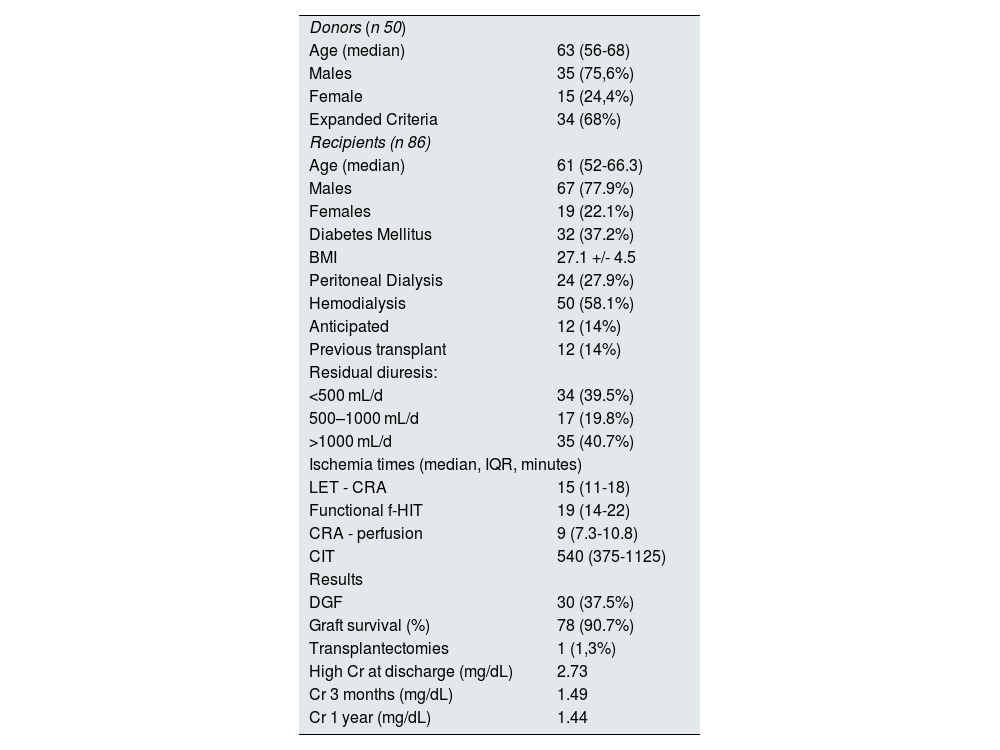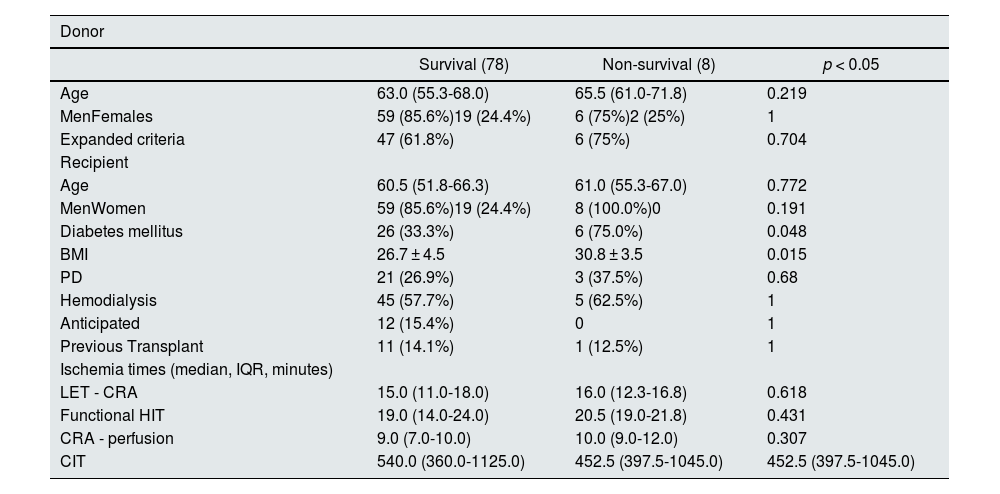Due to organ shortages, kidney transplantation (KT) from donors with expanded criteria (ECD) and donation after asystole (AD) has increased in recent years.
The impact of different times of ischemia during donation and donor and recipient characteristics on graft survival in AD have been poorly studied. In the present study, we analyze which peri-transplant factors can predict graft survival in our AD KT program.
This analysis included prospectively the data of all controlled AD KTs performed at the Son Espases University Hospital from June 2016 to November 2019. Renal extraction was performed by the ultra-rapid technique, the preservation method was cold storage, and the preservation solution was Wisconsin® fluid. The immunosuppression induction protocol included antithymocyte globulin or basiliximab, while steroids, tacrolimus and mycophenolate or everolimus were used during maintenance.
During the study period, there were 86 KTs were performed from controlled AD (Table 1). At the time of analysis, the median follow-up after transplantation was 2.3 years.
Descriptive data.
| Donors (n 50) | |
| Age (median) | 63 (56-68) |
| Males | 35 (75,6%) |
| Female | 15 (24,4%) |
| Expanded Criteria | 34 (68%) |
| Recipients (n 86) | |
| Age (median) | 61 (52-66.3) |
| Males | 67 (77.9%) |
| Females | 19 (22.1%) |
| Diabetes Mellitus | 32 (37.2%) |
| BMI | 27.1 +/- 4.5 |
| Peritoneal Dialysis | 24 (27.9%) |
| Hemodialysis | 50 (58.1%) |
| Anticipated | 12 (14%) |
| Previous transplant | 12 (14%) |
| Residual diuresis: | |
| <500 mL/d | 34 (39.5%) |
| 500–1000 mL/d | 17 (19.8%) |
| >1000 mL/d | 35 (40.7%) |
| Ischemia times (median, IQR, minutes) | |
| LET - CRA | 15 (11-18) |
| Functional f-HIT | 19 (14-22) |
| CRA - perfusion | 9 (7.3-10.8) |
| CIT | 540 (375-1125) |
| Results | |
| DGF | 30 (37.5%) |
| Graft survival (%) | 78 (90.7%) |
| Transplantectomies | 1 (1,3%) |
| High Cr at discharge (mg/dL) | 2.73 |
| Cr 3 months (mg/dL) | 1.49 |
| Cr 1 year (mg/dL) | 1.44 |
Graft and patient survival were similar to other published data at three years of follow-up.1,2
Our donors and recipients were older than those in other studies.1 However, some countries reject a high percentage of aged donor kidneys, which could explain this difference. Likewise, our results showed no differences between recipients with graft survival and graft loss, as in a recent Spanish study3 (Table 2). Additionally other longitudinal records such as the cohort from Eurotransplant, UNOS, and US data, showed a relationship between donor and recipient age and graft loss.4,5 In our study, 68% of donors met the expanded criteria, a higher rate than in other studies3,6; however, this characteristic was not associated with graft loss (Table 2). In addition, ECDs were more common in the group with graft loss. Some studies, such as in the U.S., found no differences between ECDs and non-ECDs with respect to graft survival,5 while others did.2,3,7 However, it should be noted that most of the studies mentioned were retrospective and combined both static and perfusion machine cold storage systems, as well as their increased number of rejected ECDs.7
Factors related to graft survival.
| Donor | |||
|---|---|---|---|
| Survival (78) | Non-survival (8) | p < 0.05 | |
| Age | 63.0 (55.3-68.0) | 65.5 (61.0-71.8) | 0.219 |
| MenFemales | 59 (85.6%)19 (24.4%) | 6 (75%)2 (25%) | 1 |
| Expanded criteria | 47 (61.8%) | 6 (75%) | 0.704 |
| Recipient | |||
| Age | 60.5 (51.8-66.3) | 61.0 (55.3-67.0) | 0.772 |
| MenWomen | 59 (85.6%)19 (24.4%) | 8 (100.0%)0 | 0.191 |
| Diabetes mellitus | 26 (33.3%) | 6 (75.0%) | 0.048 |
| BMI | 26.7 ± 4.5 | 30.8 ± 3.5 | 0.015 |
| PD | 21 (26.9%) | 3 (37.5%) | 0.68 |
| Hemodialysis | 45 (57.7%) | 5 (62.5%) | 1 |
| Anticipated | 12 (15.4%) | 0 | 1 |
| Previous Transplant | 11 (14.1%) | 1 (12.5%) | 1 |
| Ischemia times (median, IQR, minutes) | |||
| LET - CRA | 15.0 (11.0-18.0) | 16.0 (12.3-16.8) | 0.618 |
| Functional HIT | 19.0 (14.0-24.0) | 20.5 (19.0-21.8) | 0.431 |
| CRA - perfusion | 9.0 (7.0-10.0) | 10.0 (9.0-12.0) | 0.307 |
| CIT | 540.0 (360.0-1125.0) | 452.5 (397.5-1045.0) | 452.5 (397.5-1045.0) |
Different results have been published on the effect of the duration of hot ischemia. The Eurotransplant cohort revealed an association with graft loss, while the UK cohort did not.1 Our data showed that functional hot ischemia time (f-HIT) was not associated with graft loss (Table 2). However, the f-HIT in the graft loss group was longer than in the graft survival group, but without statistical significance. On the other hand, cold ischemia time (CIT) has been strongly associated to graft loss in DA KT.8 Our data did not show this association. It is worth noting that, in our registry, the CIT was shorter than that described by other centers9 and that this favorable CIT could have masked any negative impacts of CIT. Our CIT is explained by the analysis of the KTs that have only been performed in this center, without taking into account kidneys referred to other centers, which would have prolonged the CIT.
Finally, other ischemia times such as the agonal phase and the time from cardiorespiratory arrest (CRA) to perfusion were not related to graft loss (Table 2). The only previously published study on the impact of the agonal phase on AD KT demonstrated no relationship between this time and graft survival.10 On the other hand, the impact of time from CRA to perfusion on graft survival had not been previously analyzed.
Regarding delayed graft function (DGF), the present study found a lower rate than other published data1,2 and that it was not related to graft loss, as were other recently published results.2
AD has evolved in recent decades, with increased use of ECD to meet the increasing demands of RT. Our results reveal that the use of these donors does not result in graft loss. Graft loss was determined by the recipient's diabetes mellitus and BMI, but not by ischemia times or donor or recipient age, as in some previously published studies.
FundingThis research has not received specific support from public sector agencies, the commercial sector or non-profit entities.
Conflict of interestsAll authors declare no conflicts of interest.
The authors would like to thank Ana Rosa Millán for her help in the statistical analysis.








